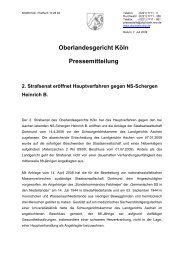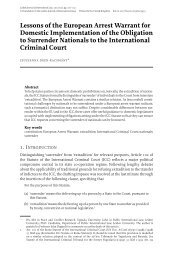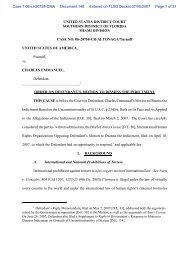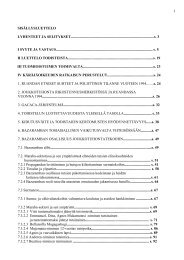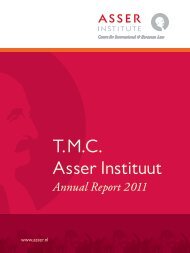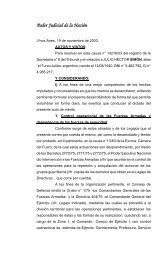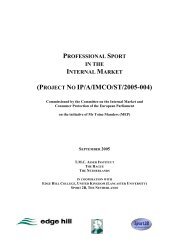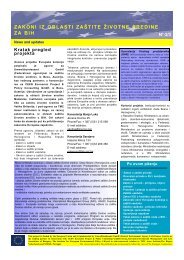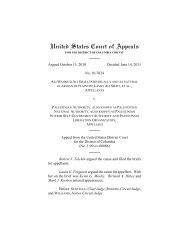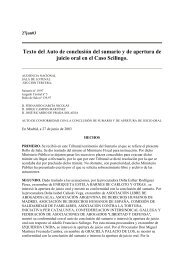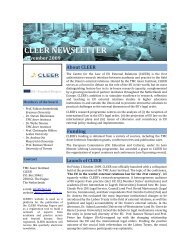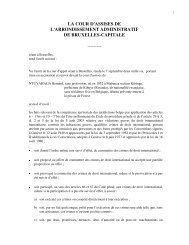Islj 2009 3-4 - TMC Asser Instituut
Islj 2009 3-4 - TMC Asser Instituut
Islj 2009 3-4 - TMC Asser Instituut
Create successful ePaper yourself
Turn your PDF publications into a flip-book with our unique Google optimized e-Paper software.
sports agent will not bargain at arm’s length and will not serve the athlete<br />
in his best interest. It is hard to monitor for an athlete, whether<br />
the sports agent is serving his interest. It leads to information asymmetry<br />
between the sports agent and the athlete.<br />
In principle, the sports agents will be bargaining at arm’s length,<br />
but the clubs can increase the influence on the sports agent. Due to<br />
the information asymmetry, the sports agent cannot be monitored<br />
fully.<br />
2.5. Conclusion<br />
In this chapter, several economic theories have been discussed, which<br />
are relevant in the market of sports agents. Economic theories like<br />
monopsonistic market, winner’s curse, moral hazard and bargaining<br />
at arm’s length are very important. With the explanation of these theories,<br />
the understanding of the market of sports agents should be better<br />
for the reader. It should be clear what the role of a sports agent is<br />
in the labor relation between athletes and the clubs. Decades ago, the<br />
bargaining power was with the clubs, because they had monopsonistic<br />
power. It has changed by regulations and the professionalizing of<br />
sports. The power shifted to the athletes, which had to use sports<br />
agents in order to get the best contract. The dependency of athletes<br />
on sports agents lead to an increase in power of the sports agent. The<br />
change of power lead to the creation of the market of sports agents<br />
and the power of sports agents is still increasing. There is regulation<br />
(and more needed) to restrain the power of the sports agents. In the<br />
next chapter, there will be an overview of the regulations in the market<br />
of sports agents.<br />
3. Regulation of the market of sports agents<br />
In this chapter, there will be a review of the literature from the academic<br />
world. In chapter 2, there has been referred to several papers.<br />
In order to avoid repeating myself, the articles already explained in<br />
chapter 2 will not be discussed extensively. After that, the regulations<br />
will be explained, which affects the sports agents in the Netherlands.<br />
The focus of the regulations will be on the Netherlands and Europe.<br />
Regulations from the USA will not be included, unlike the literature.<br />
3.1. Labor market of professional sports<br />
There is a lot of academic literature about the labor market available.<br />
In the previous chapter, I have used some of the literature already.<br />
There are some interesting articles which will be discussed shortly in<br />
this chapter. In most articles about this specific topic, there is referred<br />
to Rottenberg (1956).<br />
Rottenberg was the first to investigate the labor market for athletes<br />
from an economic point of view.<br />
Rottenberg focused on the American sports, like most research in<br />
professional sports. His research was done with the assumption of the<br />
frictionless world of the Coase theorem. He found that free agency<br />
has no effect on the player allocation. The most important difference<br />
was who would get the money.<br />
In the case of free agency, more money would go to the athletes. It<br />
would have some important implications for professional sports<br />
worldwide, but the assumptions he made are very strong and these<br />
assumptions will not hold in the real world. One implication could<br />
be that the free agency did not have any influence on the mobility of<br />
an athlete. Some of the assumptions Rottenberg made were: perfect<br />
information, transactions costs are zero and that the wealth effects are<br />
zero. These assumptions are strong and not always realistic. If the<br />
assumptions do not hold, than the free agency could play a role in the<br />
player allocation (Rottenberg, 1956).<br />
Rosen and Sanderson (2001) also wrote an interesting article about<br />
the labor markets in professional sports. They find that it is easy for<br />
clubs to measure the marginal product of labor, because there are a lot<br />
of stats available of the individual player. In this way, it is easy to calculate<br />
the marginal product of labor for an individual player. They<br />
find something interesting, which is a well-known labor market<br />
observation, the variation in starting wages in professions is much<br />
smaller than the variation in wages of more experienced workers. The<br />
wages of athletes will increase by their work ethic and abilities to<br />
learn. At the start, when they are rookies, most salaries of different<br />
players are the same. They also refer, like many authors in the field of<br />
labor economics, to the case of wage discrimination. In many team<br />
sports, wage discrimination was present in the 70’s and 80’s, but in the<br />
90’s the wage discrimination was not easily to detect. In the book of<br />
Sandy, Sloane and Rosentraub (2004), they support the finding of<br />
Rosen and Sanderson (2001) that the marginal product of labor is easily<br />
to measure for clubs. They state that there are some difficulties in<br />
determining the marginal product of labor, like cross-player complementarities<br />
and future uncertainty. It has been discussed extensively<br />
in chapter 2.2.<br />
Quirk and Fort (1999) wrote a chapter about the players. It is an<br />
interesting chapter, if a reader wants to know more about the players,<br />
I have to recommend reading it. The public opinion thinks that the<br />
high salaries of the athletes are leading to the higher costs of the tickets<br />
in a stadium. This is not the case, because the higher salaries only<br />
reflect the value of a player to the team. The higher demand towards<br />
professional sports leads to the multi-billion dollar industry, which it<br />
is nowadays. So, the higher demand towards professional sports is<br />
leading to the higher salaries of athletes. An important feature of the<br />
higher demand is how high the competitive balance is. When there is<br />
more competition between clubs on the field, the crowd will like the<br />
sport more (Groot, 2008). The writers represent gate-sharing as a<br />
solution to the escalating player salaries, but these salaries are still the<br />
value of a player. The gate-sharing will not be discussed in this<br />
research as a regulation, because in Europe it is not a regulation.<br />
3.2. The business of sports agents<br />
Shropshire and Davis (2008) wrote a book about the business of<br />
sports agents. The book is focused primarily on the American sports,<br />
but the experiences in these sports can be used for the European<br />
sports. The sports agent has a long tradition in the American sports.<br />
A standard anecdote is told in this book about the coach of the green<br />
bay packers, Vincent Lombardi.<br />
‘It was time to negotiate center Jim Ringo’s contract for the coming<br />
year. The player came into the office with a gentleman wearing<br />
a suit. When Lombardi asked the player to identify the gentleman,<br />
Ringo responded that he had come to help in the contract negotiation.<br />
The story has it that Lombardi excused himself, stepped into<br />
the next room, and made a phone call. When he returned he<br />
informed Ringo that he was negotiating with the wrong team<br />
because he had just been traded to Philadelphia.’ (Shropshire &<br />
Davis, 2008, p. 12)<br />
This anecdote is illustrating how most team owners or managers looked<br />
towards the profession of sports agents. They think the sports agents are<br />
just there for a fast buck, but this view has changed over time. The anecdote<br />
is from the 60’s and there are some changes since then, as<br />
explained before, which have lead to the acceptance of sports agents.<br />
There are some problems arising in the business of sports agents,<br />
which have led to the need of regulation stated before. There is the<br />
danger of unethical behavior by the sports agents, when they want to<br />
attract young talented athletes. Some stories tell that the unethical<br />
behavior differs from giving money, gifts or even threaten the talents<br />
to sign a contract with the sports agent. In order to avoid this unethical<br />
behavior or in some cases even criminal behavior. Specific regulation<br />
is needed to restrain the power of a sports agent and to increase<br />
the control on sports agents. There are several solutions presented to<br />
overcome these problems in the book of Shropshire and Davis (2008).<br />
The specific laws explained in the book are not interesting for the<br />
research, because the laws are mainly on a state level or federal level in<br />
the USA.<br />
Another book about the business of sports agent is written by Stein<br />
(2008), with the main focus on England and especially on the regulations<br />
of the Football Association (FA). Mel Stein is a sports agent<br />
himself and wrote the book to give some insights in the different regulations<br />
of the FA, with a cynical view on the regulations and the<br />
license. It is not an academic book, but it gives insight in the business<br />
of sports agent from the point of view of a sports agent. It becomes<br />
80 <strong>2009</strong>/3-4<br />
A RT I C L E S



